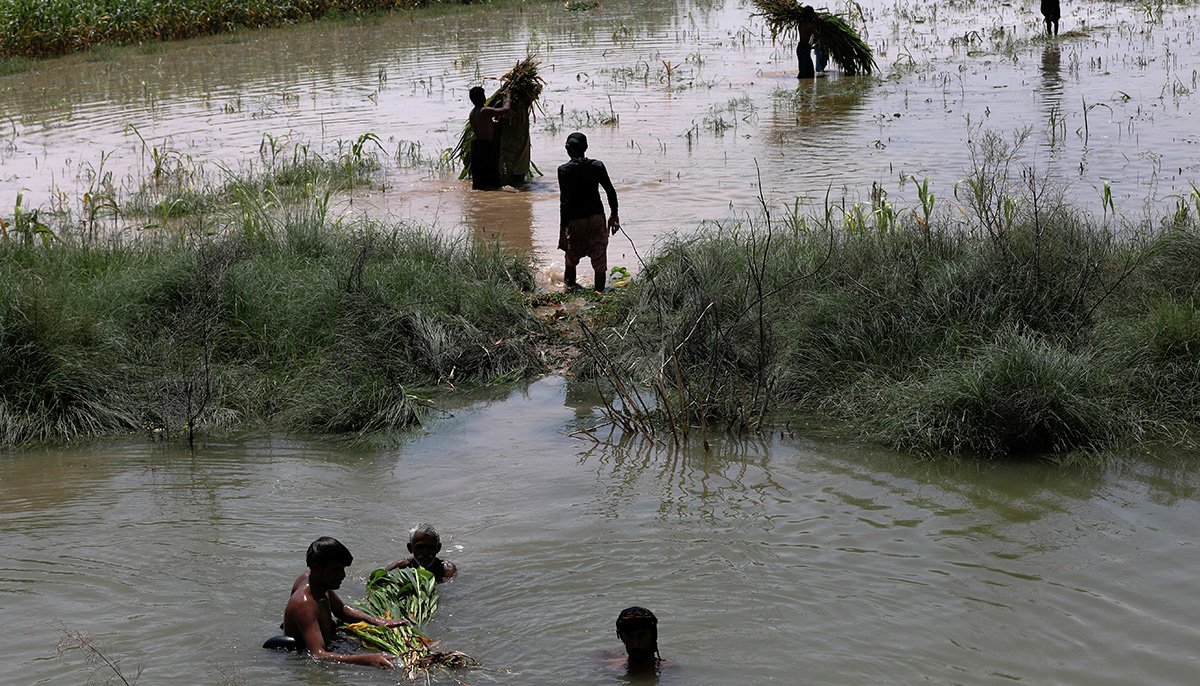[ad_1]
Unprecedented flash floods, caused by historic monsoon rains, have washed away roads, crops, infrastructure and bridges in Pakistan, killing over 1,100 people since mid-June and affecting more than 33 million.
Pakistan’s central bank had already flagged the heavy rainfall as a threat to the economic output, given its impact on the agriculture sector.
As per an early and preliminary estimate by government officials, the damage from the floods could exceed $10 billion.
Till now, the southern, southwestern and northern belt have been the hardest-hit by the floods. Large swaths of farmlands and stored crops in these areas have been devastated.
Recently, Pakistan’s Minister for Planning Development Ahsan Iqbal told Reuters that 45% of the cotton crops had been washed away, while early wheat sowing in southern Pakistan has also been affected. Moreover, many rice fields, as well as lands where vegetables and fruits are planted, have been inundated.
Seasonal crops are critical to the economy, particularly cotton which makes up more than 60% of the country’s exports, according to the data of the finance ministry.
The Karachi-based Arif Habib Limited in its report titled ‘Floods 2022 – Inundated with Economic Woes’, states that Pakistan has recorded the worst floods since 2010, with rainfall crossing 390 mm this season. This is “three times higher than the national 30-year-average of 135 mm,” it adds.
The report further notes that the impact of the calamity is expected to last 30-45 days, while the rehabilitation process will take much longer. It also estimates around Rs1.2 trillion ($5.3 billion) in losses to the economy, which is around 1.48% of the gross domestic product (GDP).

Arif Habib Limited forecasts the GDP growth to shrink to 2.49% in the fiscal year 2022-23, against earlier base case assumption of 2.97%. But a rebound is expected the following year with GDP to settle at 4.4%.
It calculated the current account deficit to grow by $1.98 billion, due to the import of food commodities and shrinking exports of textile, rice and sugar given the shortage in the country and inflation to witness further pressure this quarter, settling at 19.7% in the financial year 2023.
It also expects short-term demand to hit the cement, steel, automobile, oil marketing companies and fertilizer sectors. However, the majority of these sectors could likely benefit from the rehabilitation process.
Analysts and economists Geo.tv spoke to paint an even grimmer picture, warning that the impact of the floods could be devastating for the country, which was already in the midst of an economic crisis, faced with high inflation, a depreciating currency and a current account deficit.
‘Pakistan needs addition $10-12b’
The recent floods are a “big blow” to Pakistan’s already fragile economy, explained Abid Qaiyum Suleri, the executive director at the Islamabad-based Sustainable Development Policy Institute.
He noted that the economic devastation would include infrastructure, livestock and livelihood losses; loss of standing crops, especially cotton and rice in Sindh; disruption of the supply chain of vegetables and fruits; and diversion of scarce resources from other developmental projects to flood relief and rescue.

“Pakistan requires an additional $10-12 billion for flood relief,” Suleri told Geo.tv over the phone, adding that support from friendly countries so far was keeping in mind the situation pre-floods.
The social policy analyst added that these funds will not be sufficient and Pakistan would have to mobilise more resources for an effective recovery.
‘Economy in deep waters’
Analyst Rabeea Khan said that Pakistan’s economy was already struggling to avoid a default, by securing funds from the International Monetary Fund and other lenders. Now, she added, it was in “deep waters” after the natural calamity.
While it was difficult to determine the hardest-hit sectors of the economy, she estimated agriculture, infrastructure, education and livestock to be the most devastated after the floods.

“A shortage of local food supply is inevitable, and we have already started seeing strong signs of this,” Khan warned, mentioning that supply disruptions due to floods have caused onions and tomatoes to reach the price of Rs 400-500 per kg.
It is important to note that Finance Minister Miftah Ismail has also hinted at the option of importing vegetables and other edibles from arch-rival India, to mitigate the flood-induced loss.
“A shortage of food items will not only increase prices locally and push inflation further up, but the shortage will also put an additional burden on our import bill,” Khan elaborated.
She added that a significant chunk of the government’s budget will have to be re-adjusted to compensate the displaced people and re-building will be a big challenge.
Khan suggested some of the factors that could help cushion the gap include, flood-relief aid from the international community and strict targets for tax collection. Other measures could be to revise the petroleum levy agreed with the IMF given the current crisis, which will make some room for the economy.

Also, Pakistan could approach the IMF for rapid financing of $1 billion, a facility available to all member countries to meet their urgent needs including those arising from natural disaster, price shocks etc., and the government can further request the international community to reschedule bilateral loans, which will provide some relief to Pakistan’s falling reserves.
‘Protracted food crisis may take hold’
“Early assessments indicate losses in the billions of dollars,” Uzair Younus, director of the Pakistan initiative at the US-based Atlantic Council’s South Asia Centre, told Geo.tv. Younus said this will require a major reconstruction and relief effort through government spending in the coming weeks.
“The immediate priority should be to rebuild infrastructure once the waters recede,” he explained, “And to get the agriculture sector back on its feet. Without doing so, a protracted food crisis may take hold, leading to higher inflation.”

It should be noted that prices of basic goods — particularly onions, tomatoes and chickpeas — are already soaring as vendors bemoan a lack of supplies from the flooded breadbasket provinces of Sindh and Punjab.
[ad_2]

